Examining Audit Assertions for Inventories & Intellectual Property
VerifiedAdded on 2023/06/06
|13
|2871
|115
Report
AI Summary
This assignment provides an in-depth analysis of audit assertions and their significance concerning two specific balance sheet elements: inventories and intellectual property. It begins by defining audit assertions as representations made by management during an audit engagement, covering aspects like financial statement presentation, item valuation, and recognition basis. The report identifies key assertions at risk for inventory, including valuation (due to technological obsolescence) and obligation/rights (related to goods in transit). Substantive audit procedures for mitigating these risks are outlined, such as matching inventory lists with general ledgers, observing physical counts, and scrutinizing pricing methodologies. The document also addresses the concept of Key Audit Matters (KAM) as per ASA 701, emphasizing detailed descriptions and analyses of areas requiring significant auditor attention. Furthermore, the assignment explores the valuation and ownership challenges associated with intellectual property, proposing relevant substantive audit procedures like data collection on asset nature and review of title documents. It concludes by reiterating the importance of KAM disclosures for intellectual property, highlighting the need for professional judgment and clear communication in audit reporting. The report follows the guidelines of ASA 701.
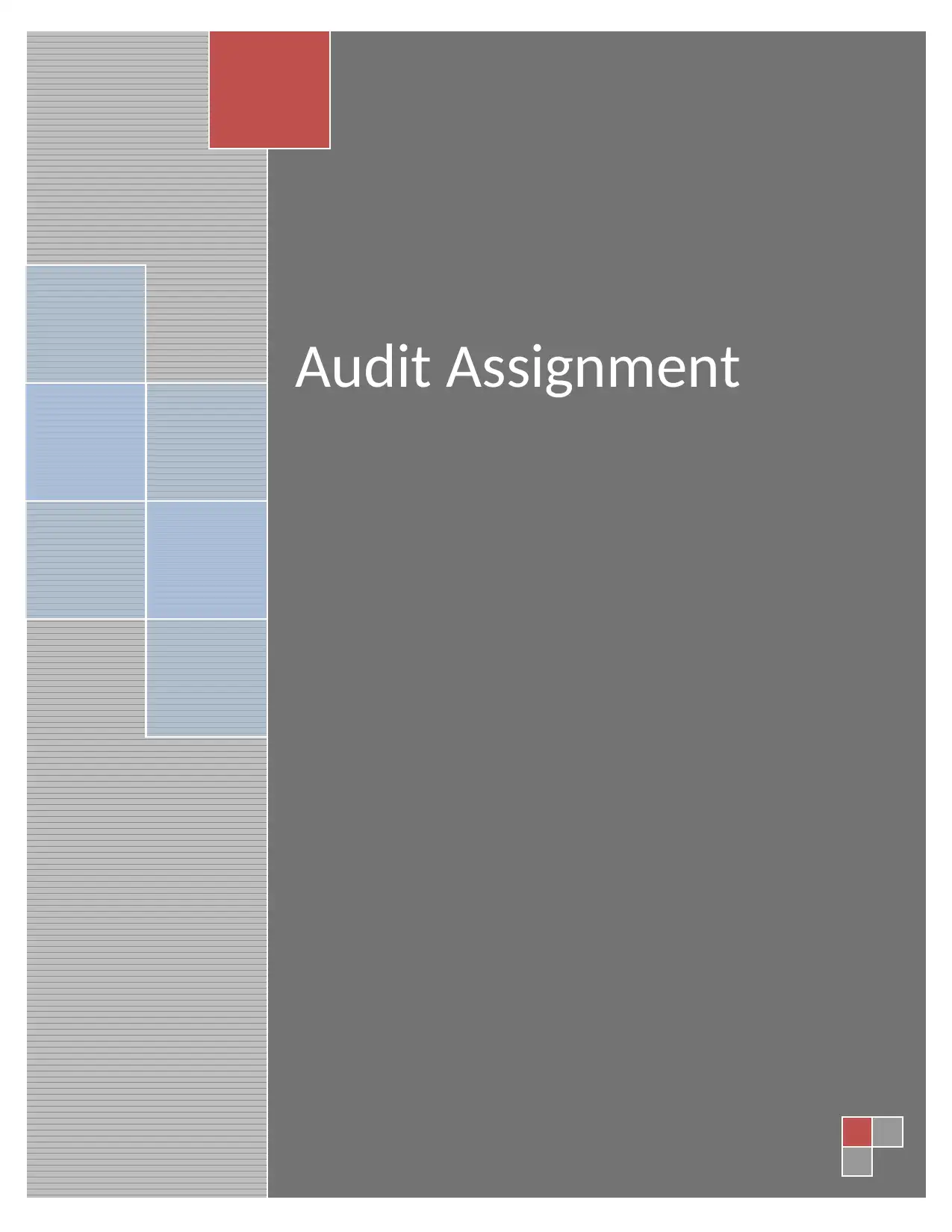
Audit Assignment
Paraphrase This Document
Need a fresh take? Get an instant paraphrase of this document with our AI Paraphraser
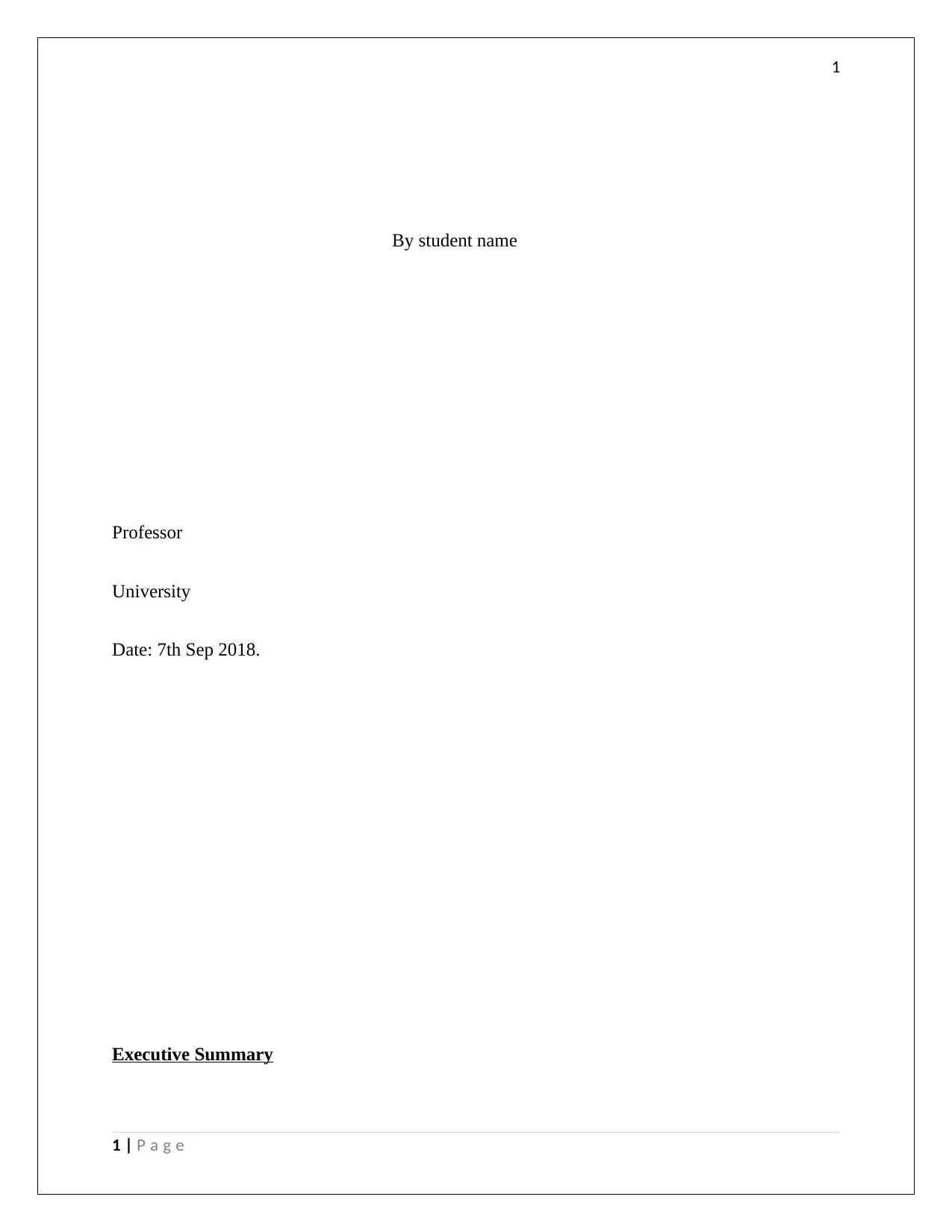
1
By student name
Professor
University
Date: 7th Sep 2018.
Executive Summary
1 | P a g e
By student name
Professor
University
Date: 7th Sep 2018.
Executive Summary
1 | P a g e
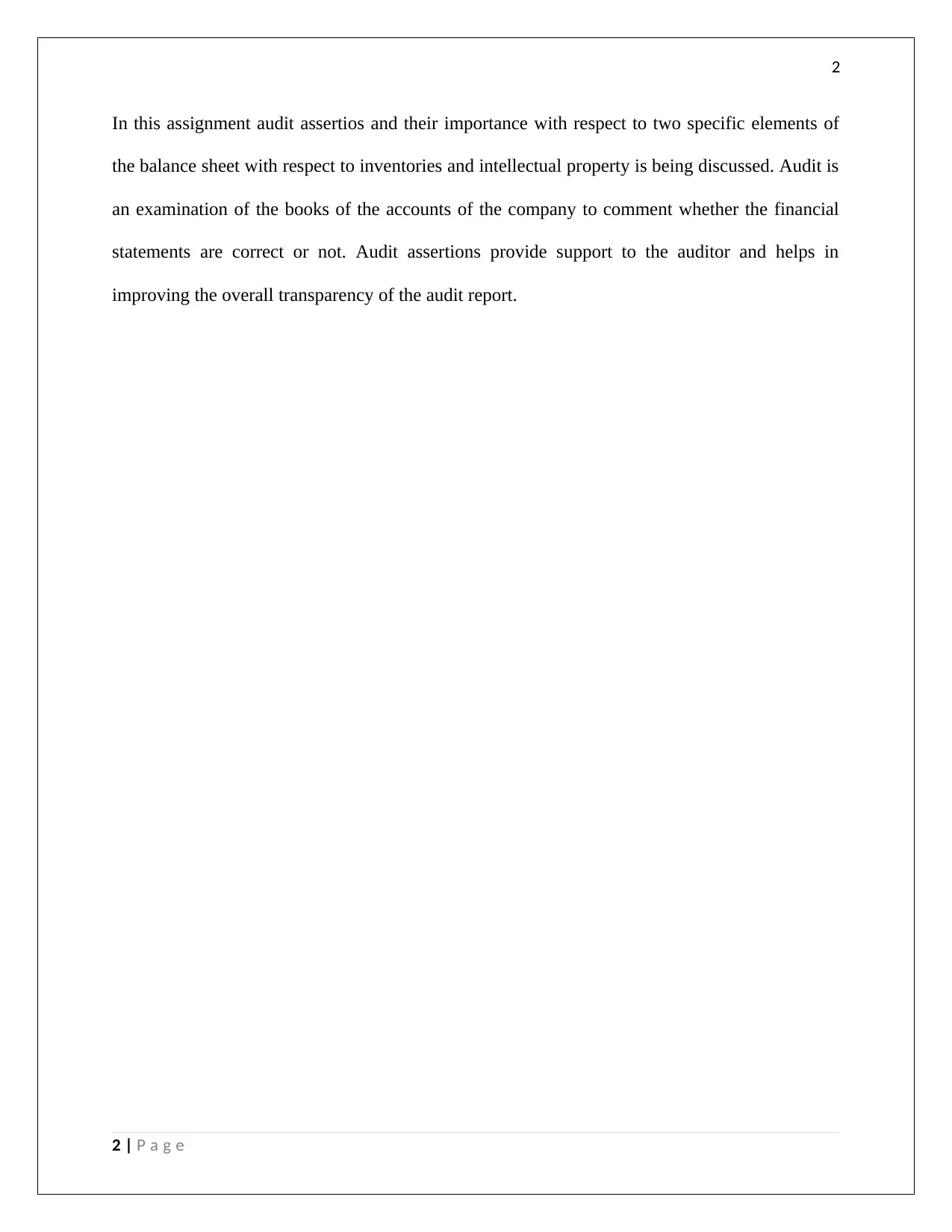
2
In this assignment audit assertios and their importance with respect to two specific elements of
the balance sheet with respect to inventories and intellectual property is being discussed. Audit is
an examination of the books of the accounts of the company to comment whether the financial
statements are correct or not. Audit assertions provide support to the auditor and helps in
improving the overall transparency of the audit report.
2 | P a g e
In this assignment audit assertios and their importance with respect to two specific elements of
the balance sheet with respect to inventories and intellectual property is being discussed. Audit is
an examination of the books of the accounts of the company to comment whether the financial
statements are correct or not. Audit assertions provide support to the auditor and helps in
improving the overall transparency of the audit report.
2 | P a g e
⊘ This is a preview!⊘
Do you want full access?
Subscribe today to unlock all pages.

Trusted by 1+ million students worldwide
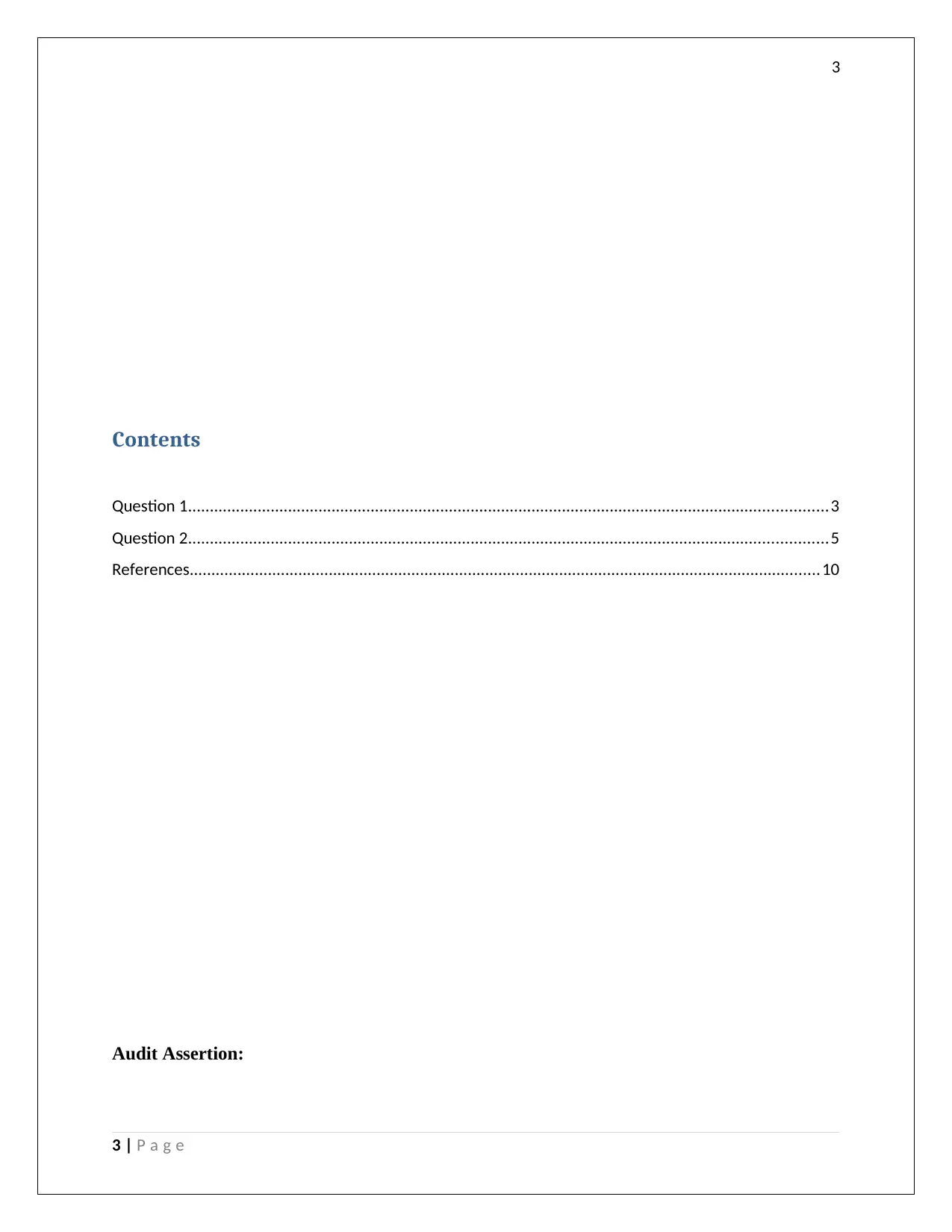
3
Contents
Question 1...................................................................................................................................................3
Question 2...................................................................................................................................................5
References.................................................................................................................................................10
Audit Assertion:
3 | P a g e
Contents
Question 1...................................................................................................................................................3
Question 2...................................................................................................................................................5
References.................................................................................................................................................10
Audit Assertion:
3 | P a g e
Paraphrase This Document
Need a fresh take? Get an instant paraphrase of this document with our AI Paraphraser
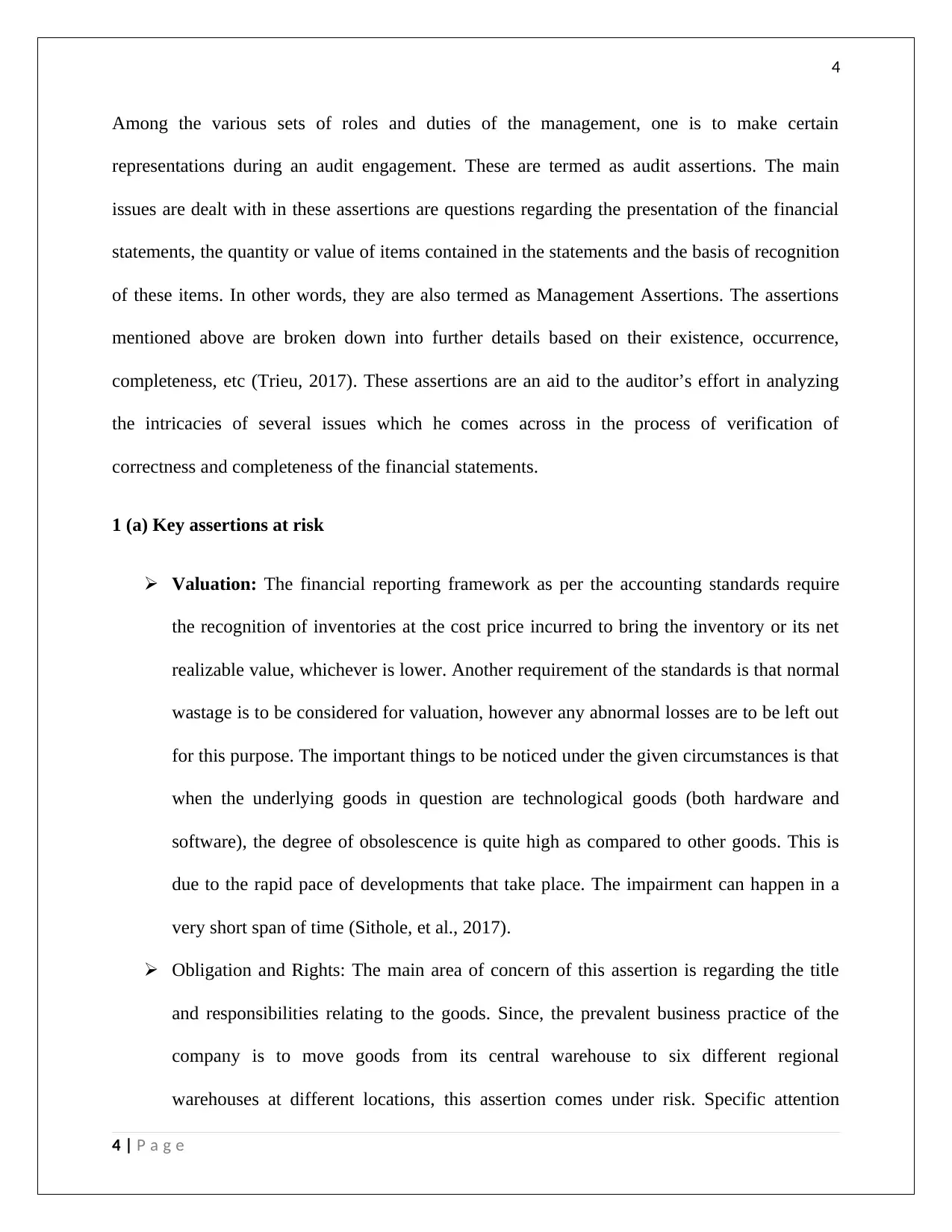
4
Among the various sets of roles and duties of the management, one is to make certain
representations during an audit engagement. These are termed as audit assertions. The main
issues are dealt with in these assertions are questions regarding the presentation of the financial
statements, the quantity or value of items contained in the statements and the basis of recognition
of these items. In other words, they are also termed as Management Assertions. The assertions
mentioned above are broken down into further details based on their existence, occurrence,
completeness, etc (Trieu, 2017). These assertions are an aid to the auditor’s effort in analyzing
the intricacies of several issues which he comes across in the process of verification of
correctness and completeness of the financial statements.
1 (a) Key assertions at risk
Valuation: The financial reporting framework as per the accounting standards require
the recognition of inventories at the cost price incurred to bring the inventory or its net
realizable value, whichever is lower. Another requirement of the standards is that normal
wastage is to be considered for valuation, however any abnormal losses are to be left out
for this purpose. The important things to be noticed under the given circumstances is that
when the underlying goods in question are technological goods (both hardware and
software), the degree of obsolescence is quite high as compared to other goods. This is
due to the rapid pace of developments that take place. The impairment can happen in a
very short span of time (Sithole, et al., 2017).
Obligation and Rights: The main area of concern of this assertion is regarding the title
and responsibilities relating to the goods. Since, the prevalent business practice of the
company is to move goods from its central warehouse to six different regional
warehouses at different locations, this assertion comes under risk. Specific attention
4 | P a g e
Among the various sets of roles and duties of the management, one is to make certain
representations during an audit engagement. These are termed as audit assertions. The main
issues are dealt with in these assertions are questions regarding the presentation of the financial
statements, the quantity or value of items contained in the statements and the basis of recognition
of these items. In other words, they are also termed as Management Assertions. The assertions
mentioned above are broken down into further details based on their existence, occurrence,
completeness, etc (Trieu, 2017). These assertions are an aid to the auditor’s effort in analyzing
the intricacies of several issues which he comes across in the process of verification of
correctness and completeness of the financial statements.
1 (a) Key assertions at risk
Valuation: The financial reporting framework as per the accounting standards require
the recognition of inventories at the cost price incurred to bring the inventory or its net
realizable value, whichever is lower. Another requirement of the standards is that normal
wastage is to be considered for valuation, however any abnormal losses are to be left out
for this purpose. The important things to be noticed under the given circumstances is that
when the underlying goods in question are technological goods (both hardware and
software), the degree of obsolescence is quite high as compared to other goods. This is
due to the rapid pace of developments that take place. The impairment can happen in a
very short span of time (Sithole, et al., 2017).
Obligation and Rights: The main area of concern of this assertion is regarding the title
and responsibilities relating to the goods. Since, the prevalent business practice of the
company is to move goods from its central warehouse to six different regional
warehouses at different locations, this assertion comes under risk. Specific attention
4 | P a g e
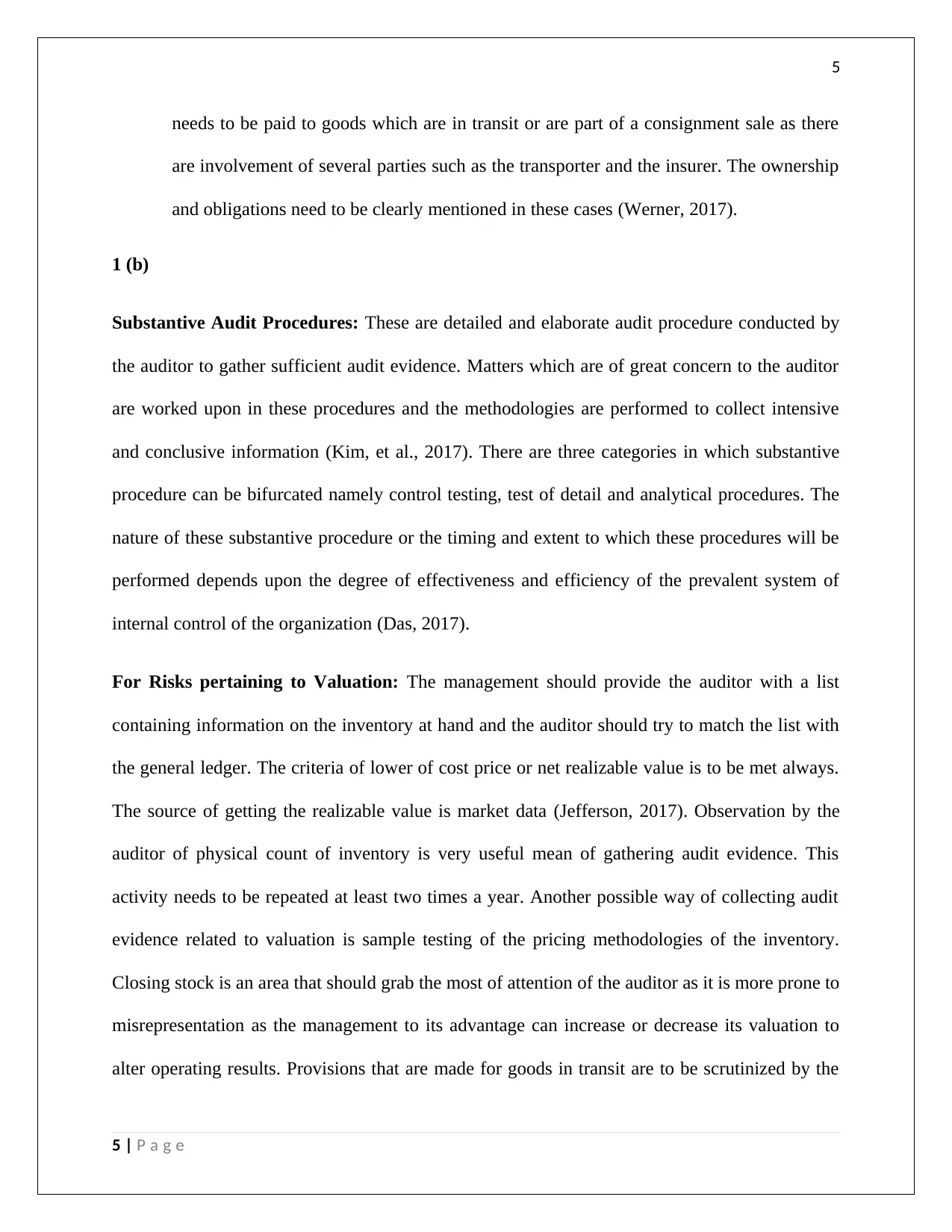
5
needs to be paid to goods which are in transit or are part of a consignment sale as there
are involvement of several parties such as the transporter and the insurer. The ownership
and obligations need to be clearly mentioned in these cases (Werner, 2017).
1 (b)
Substantive Audit Procedures: These are detailed and elaborate audit procedure conducted by
the auditor to gather sufficient audit evidence. Matters which are of great concern to the auditor
are worked upon in these procedures and the methodologies are performed to collect intensive
and conclusive information (Kim, et al., 2017). There are three categories in which substantive
procedure can be bifurcated namely control testing, test of detail and analytical procedures. The
nature of these substantive procedure or the timing and extent to which these procedures will be
performed depends upon the degree of effectiveness and efficiency of the prevalent system of
internal control of the organization (Das, 2017).
For Risks pertaining to Valuation: The management should provide the auditor with a list
containing information on the inventory at hand and the auditor should try to match the list with
the general ledger. The criteria of lower of cost price or net realizable value is to be met always.
The source of getting the realizable value is market data (Jefferson, 2017). Observation by the
auditor of physical count of inventory is very useful mean of gathering audit evidence. This
activity needs to be repeated at least two times a year. Another possible way of collecting audit
evidence related to valuation is sample testing of the pricing methodologies of the inventory.
Closing stock is an area that should grab the most of attention of the auditor as it is more prone to
misrepresentation as the management to its advantage can increase or decrease its valuation to
alter operating results. Provisions that are made for goods in transit are to be scrutinized by the
5 | P a g e
needs to be paid to goods which are in transit or are part of a consignment sale as there
are involvement of several parties such as the transporter and the insurer. The ownership
and obligations need to be clearly mentioned in these cases (Werner, 2017).
1 (b)
Substantive Audit Procedures: These are detailed and elaborate audit procedure conducted by
the auditor to gather sufficient audit evidence. Matters which are of great concern to the auditor
are worked upon in these procedures and the methodologies are performed to collect intensive
and conclusive information (Kim, et al., 2017). There are three categories in which substantive
procedure can be bifurcated namely control testing, test of detail and analytical procedures. The
nature of these substantive procedure or the timing and extent to which these procedures will be
performed depends upon the degree of effectiveness and efficiency of the prevalent system of
internal control of the organization (Das, 2017).
For Risks pertaining to Valuation: The management should provide the auditor with a list
containing information on the inventory at hand and the auditor should try to match the list with
the general ledger. The criteria of lower of cost price or net realizable value is to be met always.
The source of getting the realizable value is market data (Jefferson, 2017). Observation by the
auditor of physical count of inventory is very useful mean of gathering audit evidence. This
activity needs to be repeated at least two times a year. Another possible way of collecting audit
evidence related to valuation is sample testing of the pricing methodologies of the inventory.
Closing stock is an area that should grab the most of attention of the auditor as it is more prone to
misrepresentation as the management to its advantage can increase or decrease its valuation to
alter operating results. Provisions that are made for goods in transit are to be scrutinized by the
5 | P a g e
⊘ This is a preview!⊘
Do you want full access?
Subscribe today to unlock all pages.

Trusted by 1+ million students worldwide
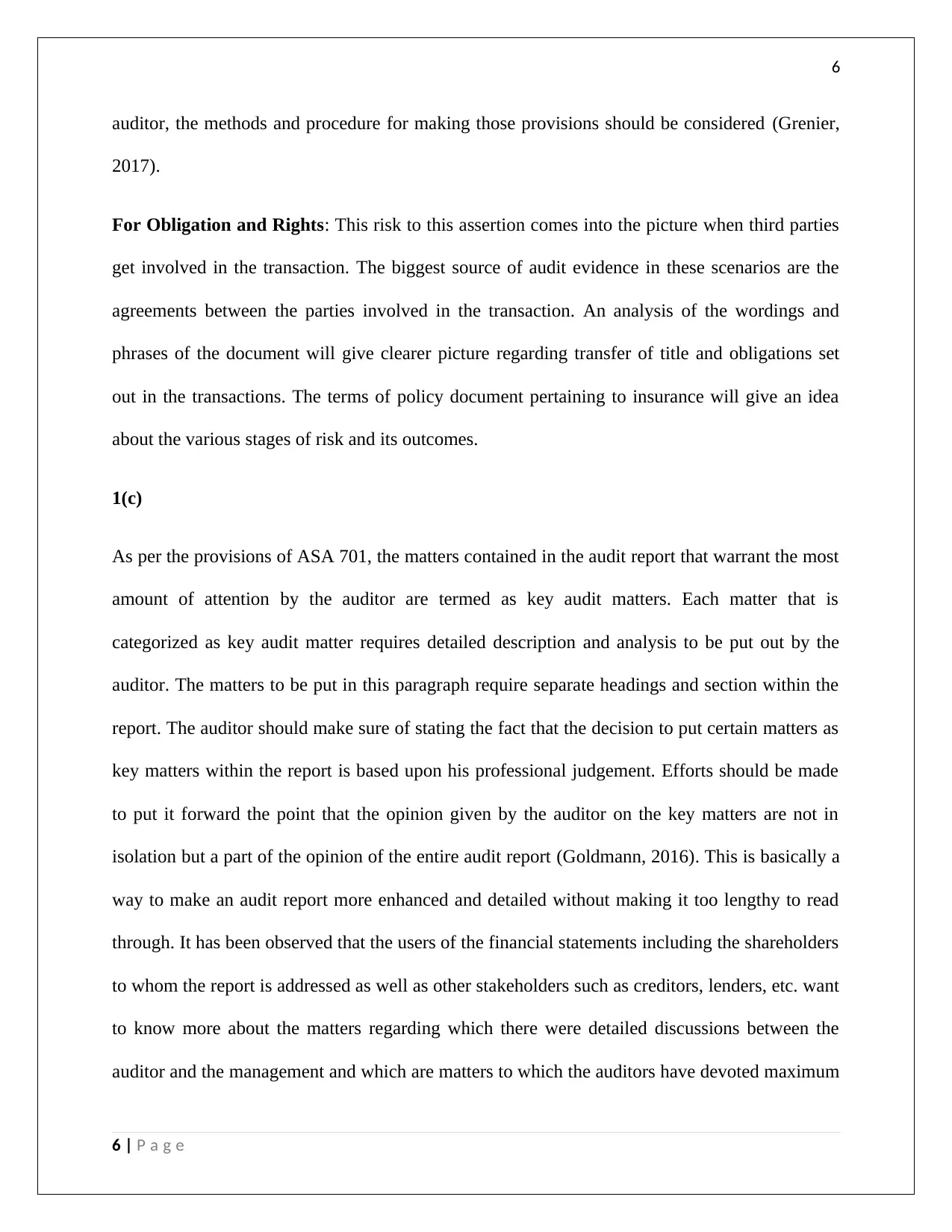
6
auditor, the methods and procedure for making those provisions should be considered (Grenier,
2017).
For Obligation and Rights: This risk to this assertion comes into the picture when third parties
get involved in the transaction. The biggest source of audit evidence in these scenarios are the
agreements between the parties involved in the transaction. An analysis of the wordings and
phrases of the document will give clearer picture regarding transfer of title and obligations set
out in the transactions. The terms of policy document pertaining to insurance will give an idea
about the various stages of risk and its outcomes.
1(c)
As per the provisions of ASA 701, the matters contained in the audit report that warrant the most
amount of attention by the auditor are termed as key audit matters. Each matter that is
categorized as key audit matter requires detailed description and analysis to be put out by the
auditor. The matters to be put in this paragraph require separate headings and section within the
report. The auditor should make sure of stating the fact that the decision to put certain matters as
key matters within the report is based upon his professional judgement. Efforts should be made
to put it forward the point that the opinion given by the auditor on the key matters are not in
isolation but a part of the opinion of the entire audit report (Goldmann, 2016). This is basically a
way to make an audit report more enhanced and detailed without making it too lengthy to read
through. It has been observed that the users of the financial statements including the shareholders
to whom the report is addressed as well as other stakeholders such as creditors, lenders, etc. want
to know more about the matters regarding which there were detailed discussions between the
auditor and the management and which are matters to which the auditors have devoted maximum
6 | P a g e
auditor, the methods and procedure for making those provisions should be considered (Grenier,
2017).
For Obligation and Rights: This risk to this assertion comes into the picture when third parties
get involved in the transaction. The biggest source of audit evidence in these scenarios are the
agreements between the parties involved in the transaction. An analysis of the wordings and
phrases of the document will give clearer picture regarding transfer of title and obligations set
out in the transactions. The terms of policy document pertaining to insurance will give an idea
about the various stages of risk and its outcomes.
1(c)
As per the provisions of ASA 701, the matters contained in the audit report that warrant the most
amount of attention by the auditor are termed as key audit matters. Each matter that is
categorized as key audit matter requires detailed description and analysis to be put out by the
auditor. The matters to be put in this paragraph require separate headings and section within the
report. The auditor should make sure of stating the fact that the decision to put certain matters as
key matters within the report is based upon his professional judgement. Efforts should be made
to put it forward the point that the opinion given by the auditor on the key matters are not in
isolation but a part of the opinion of the entire audit report (Goldmann, 2016). This is basically a
way to make an audit report more enhanced and detailed without making it too lengthy to read
through. It has been observed that the users of the financial statements including the shareholders
to whom the report is addressed as well as other stakeholders such as creditors, lenders, etc. want
to know more about the matters regarding which there were detailed discussions between the
auditor and the management and which are matters to which the auditors have devoted maximum
6 | P a g e
Paraphrase This Document
Need a fresh take? Get an instant paraphrase of this document with our AI Paraphraser
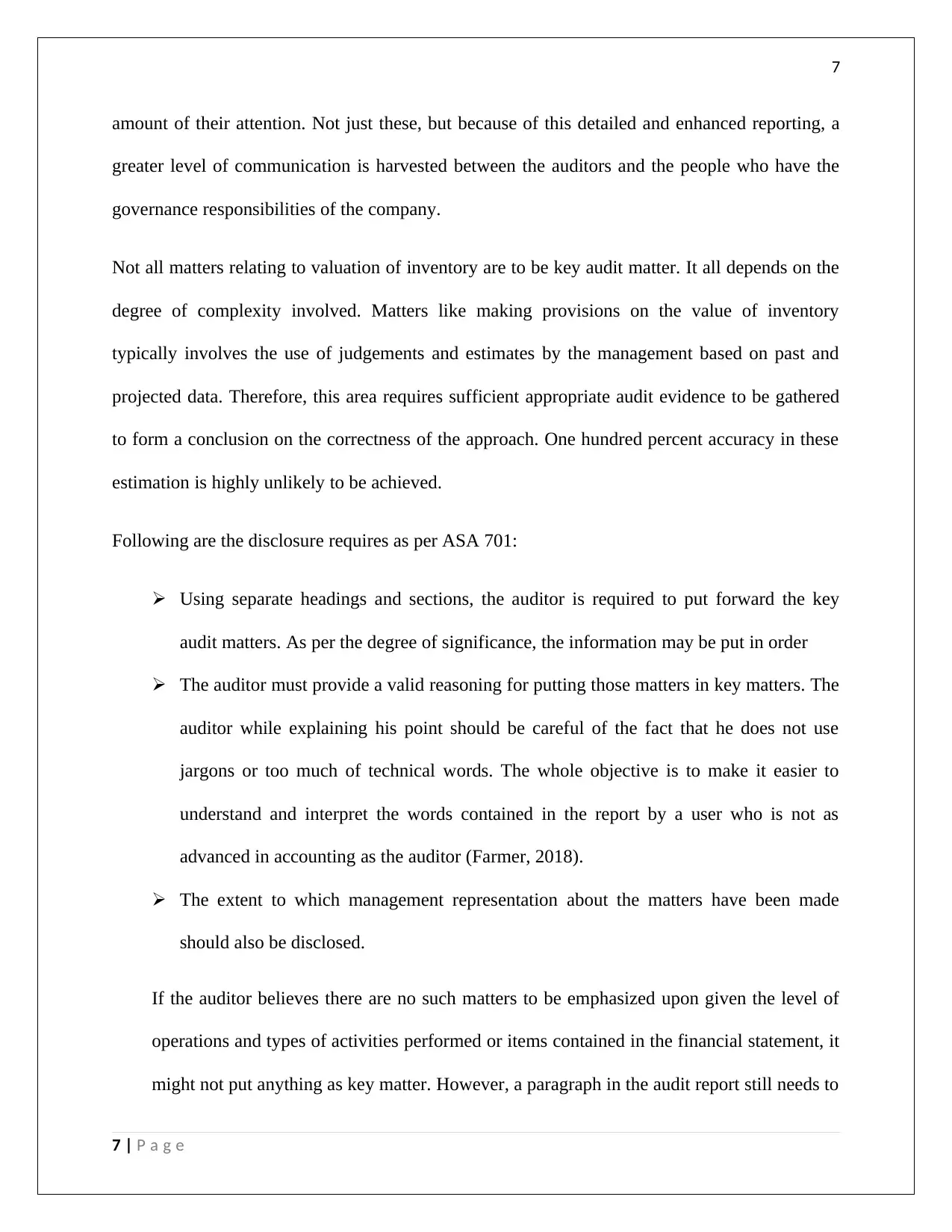
7
amount of their attention. Not just these, but because of this detailed and enhanced reporting, a
greater level of communication is harvested between the auditors and the people who have the
governance responsibilities of the company.
Not all matters relating to valuation of inventory are to be key audit matter. It all depends on the
degree of complexity involved. Matters like making provisions on the value of inventory
typically involves the use of judgements and estimates by the management based on past and
projected data. Therefore, this area requires sufficient appropriate audit evidence to be gathered
to form a conclusion on the correctness of the approach. One hundred percent accuracy in these
estimation is highly unlikely to be achieved.
Following are the disclosure requires as per ASA 701:
Using separate headings and sections, the auditor is required to put forward the key
audit matters. As per the degree of significance, the information may be put in order
The auditor must provide a valid reasoning for putting those matters in key matters. The
auditor while explaining his point should be careful of the fact that he does not use
jargons or too much of technical words. The whole objective is to make it easier to
understand and interpret the words contained in the report by a user who is not as
advanced in accounting as the auditor (Farmer, 2018).
The extent to which management representation about the matters have been made
should also be disclosed.
If the auditor believes there are no such matters to be emphasized upon given the level of
operations and types of activities performed or items contained in the financial statement, it
might not put anything as key matter. However, a paragraph in the audit report still needs to
7 | P a g e
amount of their attention. Not just these, but because of this detailed and enhanced reporting, a
greater level of communication is harvested between the auditors and the people who have the
governance responsibilities of the company.
Not all matters relating to valuation of inventory are to be key audit matter. It all depends on the
degree of complexity involved. Matters like making provisions on the value of inventory
typically involves the use of judgements and estimates by the management based on past and
projected data. Therefore, this area requires sufficient appropriate audit evidence to be gathered
to form a conclusion on the correctness of the approach. One hundred percent accuracy in these
estimation is highly unlikely to be achieved.
Following are the disclosure requires as per ASA 701:
Using separate headings and sections, the auditor is required to put forward the key
audit matters. As per the degree of significance, the information may be put in order
The auditor must provide a valid reasoning for putting those matters in key matters. The
auditor while explaining his point should be careful of the fact that he does not use
jargons or too much of technical words. The whole objective is to make it easier to
understand and interpret the words contained in the report by a user who is not as
advanced in accounting as the auditor (Farmer, 2018).
The extent to which management representation about the matters have been made
should also be disclosed.
If the auditor believes there are no such matters to be emphasized upon given the level of
operations and types of activities performed or items contained in the financial statement, it
might not put anything as key matter. However, a paragraph in the audit report still needs to
7 | P a g e
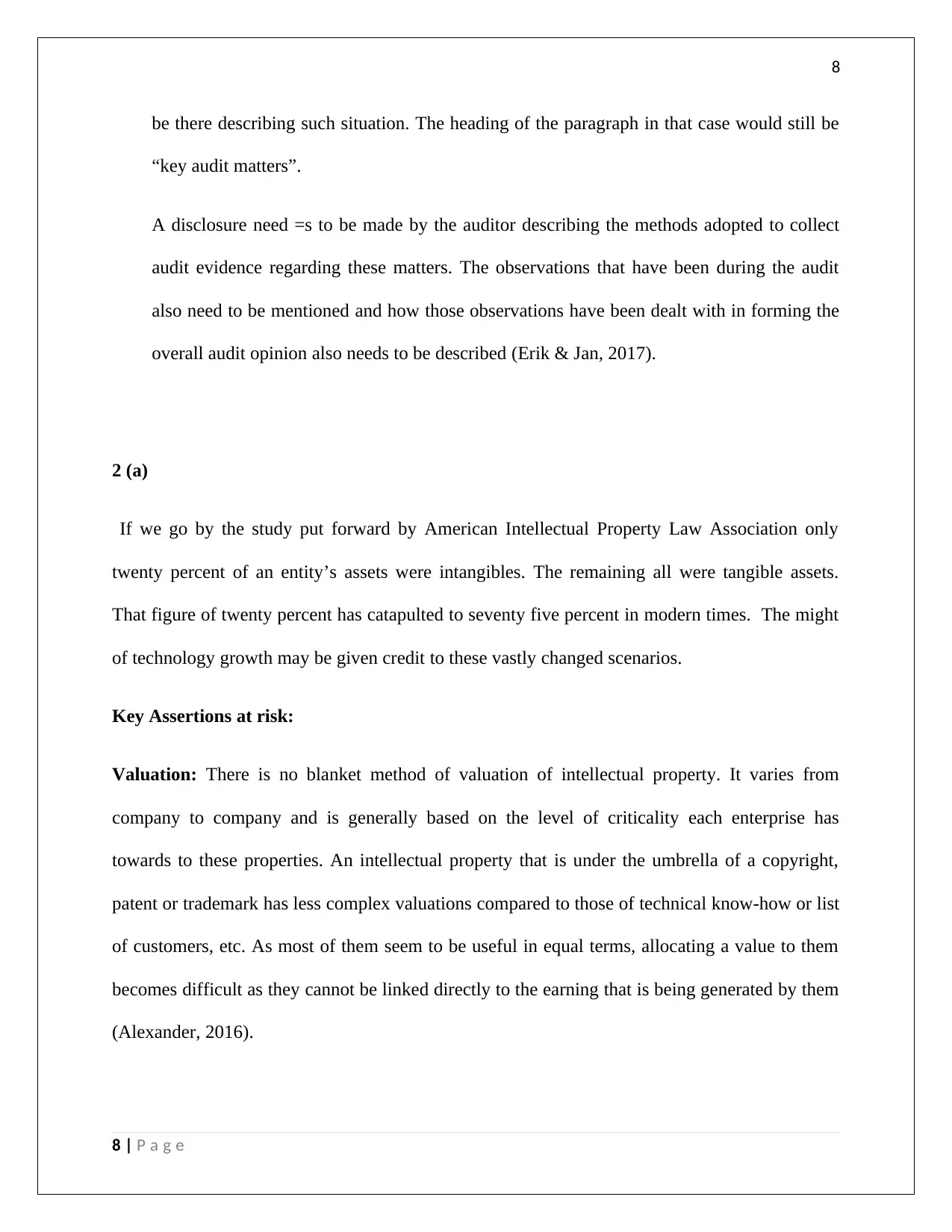
8
be there describing such situation. The heading of the paragraph in that case would still be
“key audit matters”.
A disclosure need =s to be made by the auditor describing the methods adopted to collect
audit evidence regarding these matters. The observations that have been during the audit
also need to be mentioned and how those observations have been dealt with in forming the
overall audit opinion also needs to be described (Erik & Jan, 2017).
2 (a)
If we go by the study put forward by American Intellectual Property Law Association only
twenty percent of an entity’s assets were intangibles. The remaining all were tangible assets.
That figure of twenty percent has catapulted to seventy five percent in modern times. The might
of technology growth may be given credit to these vastly changed scenarios.
Key Assertions at risk:
Valuation: There is no blanket method of valuation of intellectual property. It varies from
company to company and is generally based on the level of criticality each enterprise has
towards to these properties. An intellectual property that is under the umbrella of a copyright,
patent or trademark has less complex valuations compared to those of technical know-how or list
of customers, etc. As most of them seem to be useful in equal terms, allocating a value to them
becomes difficult as they cannot be linked directly to the earning that is being generated by them
(Alexander, 2016).
8 | P a g e
be there describing such situation. The heading of the paragraph in that case would still be
“key audit matters”.
A disclosure need =s to be made by the auditor describing the methods adopted to collect
audit evidence regarding these matters. The observations that have been during the audit
also need to be mentioned and how those observations have been dealt with in forming the
overall audit opinion also needs to be described (Erik & Jan, 2017).
2 (a)
If we go by the study put forward by American Intellectual Property Law Association only
twenty percent of an entity’s assets were intangibles. The remaining all were tangible assets.
That figure of twenty percent has catapulted to seventy five percent in modern times. The might
of technology growth may be given credit to these vastly changed scenarios.
Key Assertions at risk:
Valuation: There is no blanket method of valuation of intellectual property. It varies from
company to company and is generally based on the level of criticality each enterprise has
towards to these properties. An intellectual property that is under the umbrella of a copyright,
patent or trademark has less complex valuations compared to those of technical know-how or list
of customers, etc. As most of them seem to be useful in equal terms, allocating a value to them
becomes difficult as they cannot be linked directly to the earning that is being generated by them
(Alexander, 2016).
8 | P a g e
⊘ This is a preview!⊘
Do you want full access?
Subscribe today to unlock all pages.

Trusted by 1+ million students worldwide
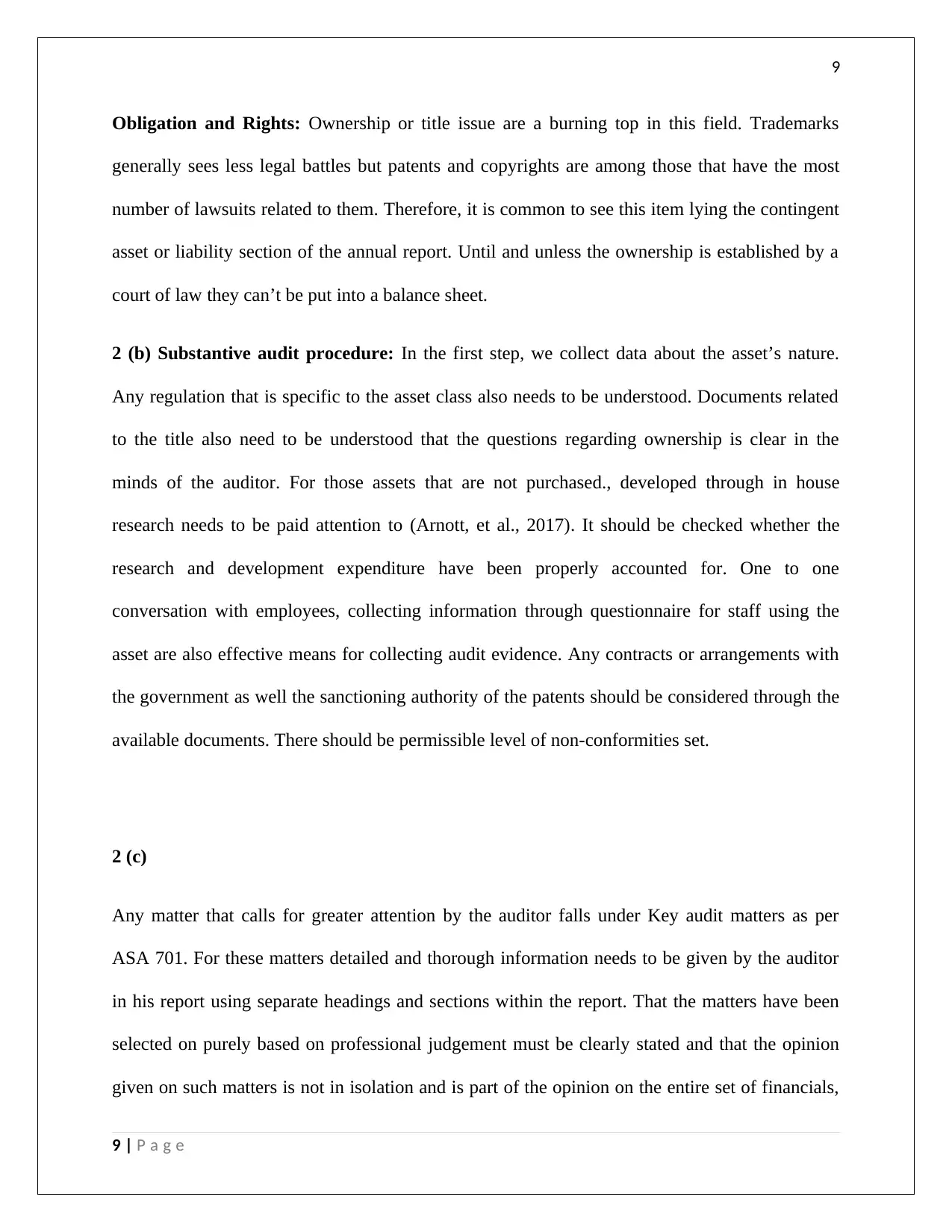
9
Obligation and Rights: Ownership or title issue are a burning top in this field. Trademarks
generally sees less legal battles but patents and copyrights are among those that have the most
number of lawsuits related to them. Therefore, it is common to see this item lying the contingent
asset or liability section of the annual report. Until and unless the ownership is established by a
court of law they can’t be put into a balance sheet.
2 (b) Substantive audit procedure: In the first step, we collect data about the asset’s nature.
Any regulation that is specific to the asset class also needs to be understood. Documents related
to the title also need to be understood that the questions regarding ownership is clear in the
minds of the auditor. For those assets that are not purchased., developed through in house
research needs to be paid attention to (Arnott, et al., 2017). It should be checked whether the
research and development expenditure have been properly accounted for. One to one
conversation with employees, collecting information through questionnaire for staff using the
asset are also effective means for collecting audit evidence. Any contracts or arrangements with
the government as well the sanctioning authority of the patents should be considered through the
available documents. There should be permissible level of non-conformities set.
2 (c)
Any matter that calls for greater attention by the auditor falls under Key audit matters as per
ASA 701. For these matters detailed and thorough information needs to be given by the auditor
in his report using separate headings and sections within the report. That the matters have been
selected on purely based on professional judgement must be clearly stated and that the opinion
given on such matters is not in isolation and is part of the opinion on the entire set of financials,
9 | P a g e
Obligation and Rights: Ownership or title issue are a burning top in this field. Trademarks
generally sees less legal battles but patents and copyrights are among those that have the most
number of lawsuits related to them. Therefore, it is common to see this item lying the contingent
asset or liability section of the annual report. Until and unless the ownership is established by a
court of law they can’t be put into a balance sheet.
2 (b) Substantive audit procedure: In the first step, we collect data about the asset’s nature.
Any regulation that is specific to the asset class also needs to be understood. Documents related
to the title also need to be understood that the questions regarding ownership is clear in the
minds of the auditor. For those assets that are not purchased., developed through in house
research needs to be paid attention to (Arnott, et al., 2017). It should be checked whether the
research and development expenditure have been properly accounted for. One to one
conversation with employees, collecting information through questionnaire for staff using the
asset are also effective means for collecting audit evidence. Any contracts or arrangements with
the government as well the sanctioning authority of the patents should be considered through the
available documents. There should be permissible level of non-conformities set.
2 (c)
Any matter that calls for greater attention by the auditor falls under Key audit matters as per
ASA 701. For these matters detailed and thorough information needs to be given by the auditor
in his report using separate headings and sections within the report. That the matters have been
selected on purely based on professional judgement must be clearly stated and that the opinion
given on such matters is not in isolation and is part of the opinion on the entire set of financials,
9 | P a g e
Paraphrase This Document
Need a fresh take? Get an instant paraphrase of this document with our AI Paraphraser
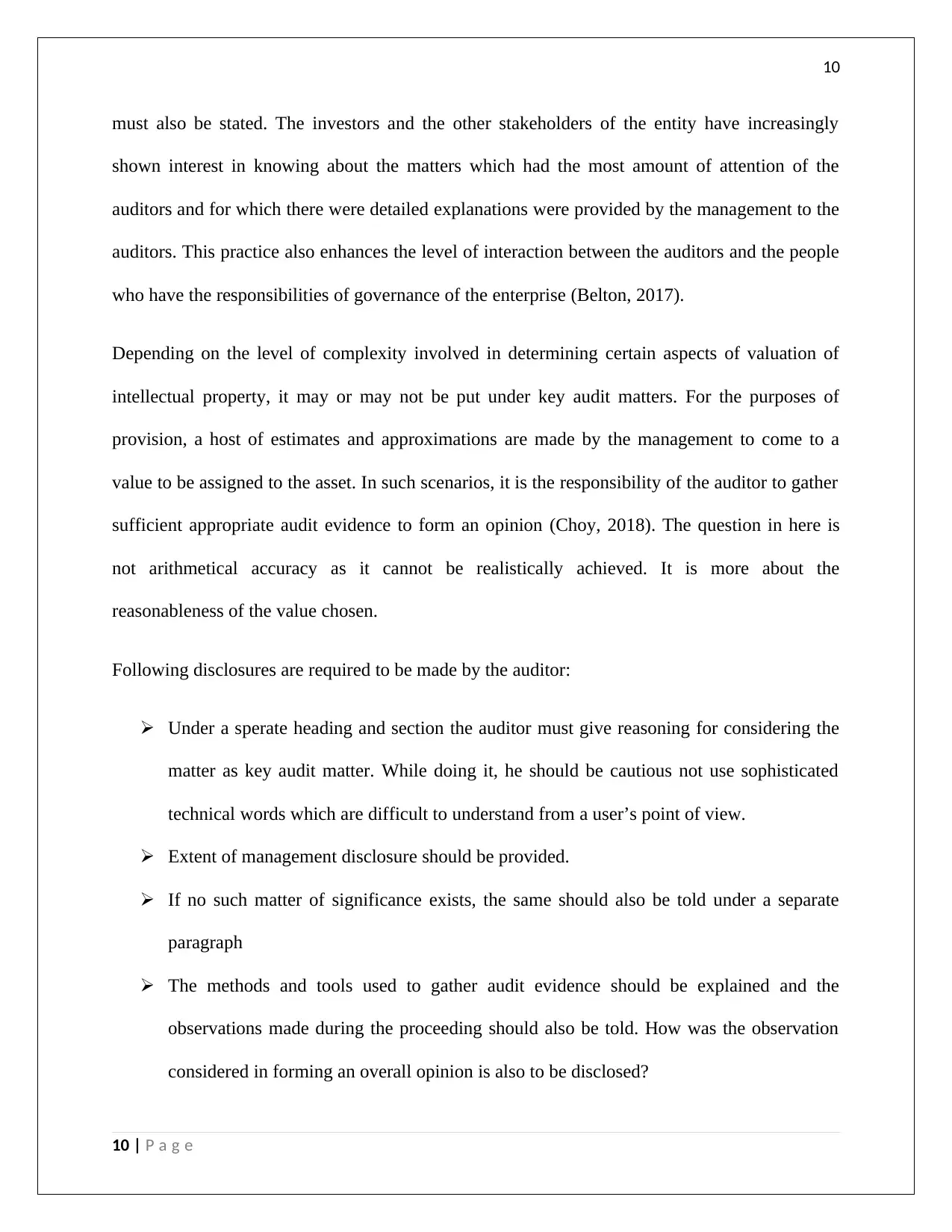
10
must also be stated. The investors and the other stakeholders of the entity have increasingly
shown interest in knowing about the matters which had the most amount of attention of the
auditors and for which there were detailed explanations were provided by the management to the
auditors. This practice also enhances the level of interaction between the auditors and the people
who have the responsibilities of governance of the enterprise (Belton, 2017).
Depending on the level of complexity involved in determining certain aspects of valuation of
intellectual property, it may or may not be put under key audit matters. For the purposes of
provision, a host of estimates and approximations are made by the management to come to a
value to be assigned to the asset. In such scenarios, it is the responsibility of the auditor to gather
sufficient appropriate audit evidence to form an opinion (Choy, 2018). The question in here is
not arithmetical accuracy as it cannot be realistically achieved. It is more about the
reasonableness of the value chosen.
Following disclosures are required to be made by the auditor:
Under a sperate heading and section the auditor must give reasoning for considering the
matter as key audit matter. While doing it, he should be cautious not use sophisticated
technical words which are difficult to understand from a user’s point of view.
Extent of management disclosure should be provided.
If no such matter of significance exists, the same should also be told under a separate
paragraph
The methods and tools used to gather audit evidence should be explained and the
observations made during the proceeding should also be told. How was the observation
considered in forming an overall opinion is also to be disclosed?
10 | P a g e
must also be stated. The investors and the other stakeholders of the entity have increasingly
shown interest in knowing about the matters which had the most amount of attention of the
auditors and for which there were detailed explanations were provided by the management to the
auditors. This practice also enhances the level of interaction between the auditors and the people
who have the responsibilities of governance of the enterprise (Belton, 2017).
Depending on the level of complexity involved in determining certain aspects of valuation of
intellectual property, it may or may not be put under key audit matters. For the purposes of
provision, a host of estimates and approximations are made by the management to come to a
value to be assigned to the asset. In such scenarios, it is the responsibility of the auditor to gather
sufficient appropriate audit evidence to form an opinion (Choy, 2018). The question in here is
not arithmetical accuracy as it cannot be realistically achieved. It is more about the
reasonableness of the value chosen.
Following disclosures are required to be made by the auditor:
Under a sperate heading and section the auditor must give reasoning for considering the
matter as key audit matter. While doing it, he should be cautious not use sophisticated
technical words which are difficult to understand from a user’s point of view.
Extent of management disclosure should be provided.
If no such matter of significance exists, the same should also be told under a separate
paragraph
The methods and tools used to gather audit evidence should be explained and the
observations made during the proceeding should also be told. How was the observation
considered in forming an overall opinion is also to be disclosed?
10 | P a g e
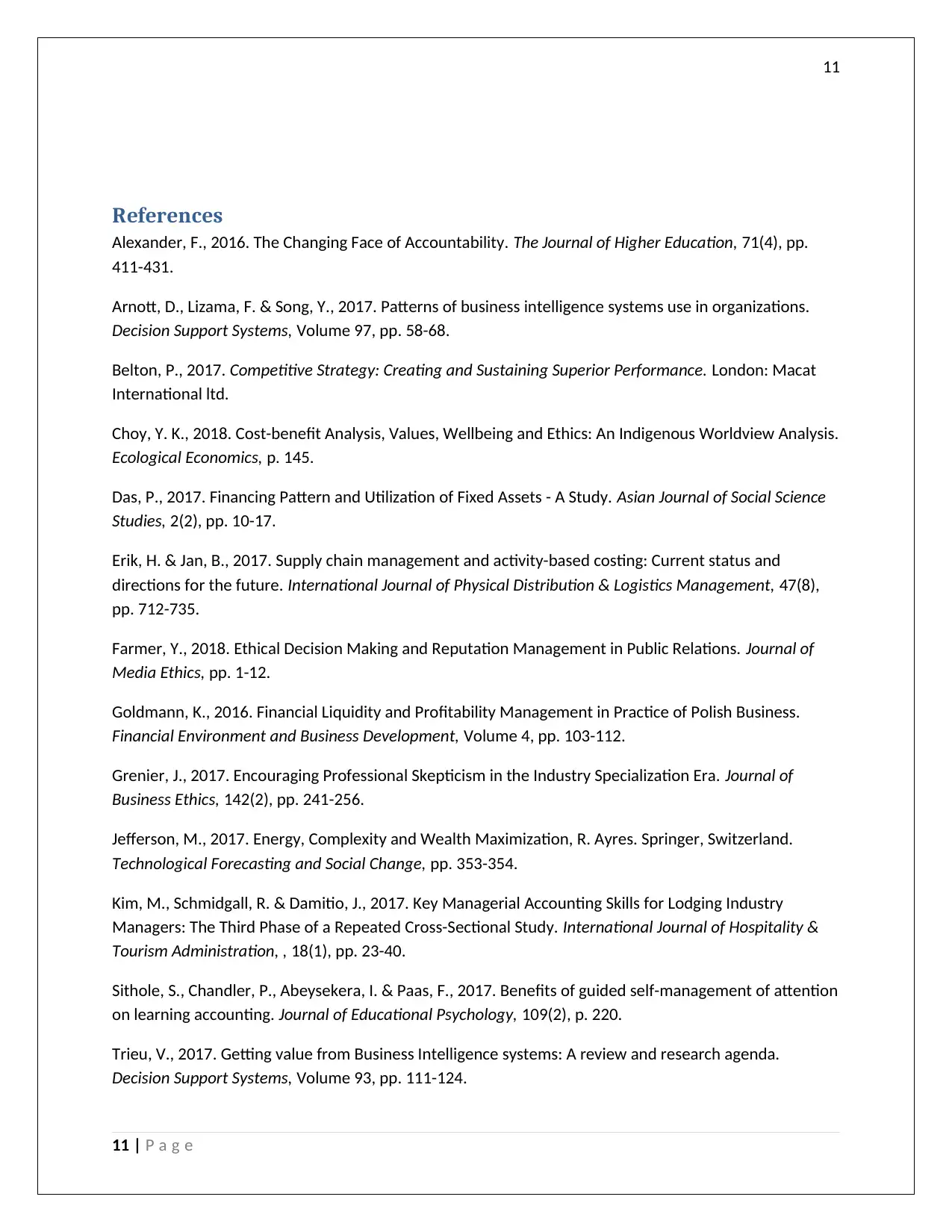
11
References
Alexander, F., 2016. The Changing Face of Accountability. The Journal of Higher Education, 71(4), pp.
411-431.
Arnott, D., Lizama, F. & Song, Y., 2017. Patterns of business intelligence systems use in organizations.
Decision Support Systems, Volume 97, pp. 58-68.
Belton, P., 2017. Competitive Strategy: Creating and Sustaining Superior Performance. London: Macat
International ltd.
Choy, Y. K., 2018. Cost-benefit Analysis, Values, Wellbeing and Ethics: An Indigenous Worldview Analysis.
Ecological Economics, p. 145.
Das, P., 2017. Financing Pattern and Utilization of Fixed Assets - A Study. Asian Journal of Social Science
Studies, 2(2), pp. 10-17.
Erik, H. & Jan, B., 2017. Supply chain management and activity-based costing: Current status and
directions for the future. International Journal of Physical Distribution & Logistics Management, 47(8),
pp. 712-735.
Farmer, Y., 2018. Ethical Decision Making and Reputation Management in Public Relations. Journal of
Media Ethics, pp. 1-12.
Goldmann, K., 2016. Financial Liquidity and Profitability Management in Practice of Polish Business.
Financial Environment and Business Development, Volume 4, pp. 103-112.
Grenier, J., 2017. Encouraging Professional Skepticism in the Industry Specialization Era. Journal of
Business Ethics, 142(2), pp. 241-256.
Jefferson, M., 2017. Energy, Complexity and Wealth Maximization, R. Ayres. Springer, Switzerland.
Technological Forecasting and Social Change, pp. 353-354.
Kim, M., Schmidgall, R. & Damitio, J., 2017. Key Managerial Accounting Skills for Lodging Industry
Managers: The Third Phase of a Repeated Cross-Sectional Study. International Journal of Hospitality &
Tourism Administration, , 18(1), pp. 23-40.
Sithole, S., Chandler, P., Abeysekera, I. & Paas, F., 2017. Benefits of guided self-management of attention
on learning accounting. Journal of Educational Psychology, 109(2), p. 220.
Trieu, V., 2017. Getting value from Business Intelligence systems: A review and research agenda.
Decision Support Systems, Volume 93, pp. 111-124.
11 | P a g e
References
Alexander, F., 2016. The Changing Face of Accountability. The Journal of Higher Education, 71(4), pp.
411-431.
Arnott, D., Lizama, F. & Song, Y., 2017. Patterns of business intelligence systems use in organizations.
Decision Support Systems, Volume 97, pp. 58-68.
Belton, P., 2017. Competitive Strategy: Creating and Sustaining Superior Performance. London: Macat
International ltd.
Choy, Y. K., 2018. Cost-benefit Analysis, Values, Wellbeing and Ethics: An Indigenous Worldview Analysis.
Ecological Economics, p. 145.
Das, P., 2017. Financing Pattern and Utilization of Fixed Assets - A Study. Asian Journal of Social Science
Studies, 2(2), pp. 10-17.
Erik, H. & Jan, B., 2017. Supply chain management and activity-based costing: Current status and
directions for the future. International Journal of Physical Distribution & Logistics Management, 47(8),
pp. 712-735.
Farmer, Y., 2018. Ethical Decision Making and Reputation Management in Public Relations. Journal of
Media Ethics, pp. 1-12.
Goldmann, K., 2016. Financial Liquidity and Profitability Management in Practice of Polish Business.
Financial Environment and Business Development, Volume 4, pp. 103-112.
Grenier, J., 2017. Encouraging Professional Skepticism in the Industry Specialization Era. Journal of
Business Ethics, 142(2), pp. 241-256.
Jefferson, M., 2017. Energy, Complexity and Wealth Maximization, R. Ayres. Springer, Switzerland.
Technological Forecasting and Social Change, pp. 353-354.
Kim, M., Schmidgall, R. & Damitio, J., 2017. Key Managerial Accounting Skills for Lodging Industry
Managers: The Third Phase of a Repeated Cross-Sectional Study. International Journal of Hospitality &
Tourism Administration, , 18(1), pp. 23-40.
Sithole, S., Chandler, P., Abeysekera, I. & Paas, F., 2017. Benefits of guided self-management of attention
on learning accounting. Journal of Educational Psychology, 109(2), p. 220.
Trieu, V., 2017. Getting value from Business Intelligence systems: A review and research agenda.
Decision Support Systems, Volume 93, pp. 111-124.
11 | P a g e
⊘ This is a preview!⊘
Do you want full access?
Subscribe today to unlock all pages.

Trusted by 1+ million students worldwide
1 out of 13
Related Documents
Your All-in-One AI-Powered Toolkit for Academic Success.
+13062052269
info@desklib.com
Available 24*7 on WhatsApp / Email
![[object Object]](/_next/static/media/star-bottom.7253800d.svg)
Unlock your academic potential
Copyright © 2020–2025 A2Z Services. All Rights Reserved. Developed and managed by ZUCOL.




